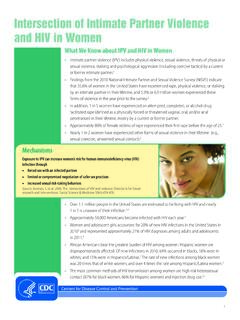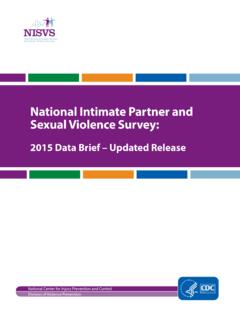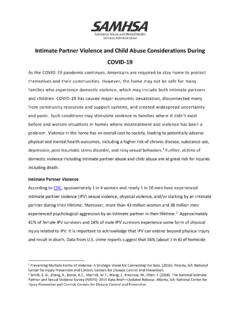Transcription of CONFLICT AND VIOLENCE IN THE 21 CENTURY
1 CONFLICT AND VIOLENCE IN THE 21ST CENTURY CURRENT TRENDS AS OBSERVED IN EMPIRICAL RESEARCH AND STATISTICS Mr. Alexandre Marc, Chief Specialist, Fragility, CONFLICT and VIOLENCE World Bank Group In the 21st CENTURY , conflicts have increased sharply since 2010 Global trends in armed CONFLICT , 1946-2014 2 020000400006000080000100000120000 Battle-related deathsTerrorist casualtiesSource: Uppsala CONFLICT Database and Global Terrorism Database Source: Center for Systemic Peace 2014 * In 2015 the number of ongoing conflicts increased to 50 compared to 41 in 2014 (Institute of Economics and Peace) Battle deaths are now largely concentrated in Middle East 3 Source:Gates et. al. Trends in Armed CONFLICT , 1946-2014. (PRIO CONFLICT Trends, January 2016). World record in forced displacement since WWII Conflicts are increasingly affecting civilians Source: Center for Systemic Peace 2014 Interpersonal VIOLENCE and gang VIOLENCE kill much more people than political VIOLENCE Interpersonal VIOLENCE exacts a high human cost 6 Source: Center for Systemic Peace 2014 Interpersonal VIOLENCE and political VIOLENCE tend to be increasingly interrelated, particularly where institutions are weak and social norms have become tolerant of VIOLENCE .
2 Interpersonal VIOLENCE seems to be declining but remains very high in some regions Source: UNODC Global Study on Homicide Source: Global status report on VIOLENCE prevention 2014 Gender based VIOLENCE remains very high, with negative consequences for both societies and economies 1 in 3 women in the world have experienced physical or sexual VIOLENCE mostly by an intimate partner (World Health Organization) It is estimated that close to 90% of current war casualties are civilians, the majority of whom are women and children, compared to a CENTURY ago when 90% of those who lost their lives were military personnel Contextual factors, such as humanitarian crises, including CONFLICT and post- CONFLICT situations, may increase women s vulnerability to VIOLENCE (UN Women) 2 in 3 victims of intimate partner /family related homicide are women ( united nations Statistics Division, The World s Women 2015) VIOLENCE and CONFLICT do not affect all regions the same way 9 Battle deaths over 300 from 2010-2014 Source: UCDP data Homicide rate over 11 (per 100,000 people) Source.
3 UNODC 2014 Conflicts and VIOLENCE are persistent and often extremely costly Many countries and subnational areas now face cycles of repeated VIOLENCE , weak governance, and instability. (WDR 2011) The aggregate economic and financial cost of CONFLICT in 2014 was estimated to be $ billion, or of the global economy (Institute for Economics and Peace) More than half of all states affected by ongoing conflicts are also affected by protracted armed conflicts persisting for more than 10 years (Center for Systemic Peace) 90 percent of the last decade s civil wars occurred in countries that had already had a civil war in the last 30 years. (WDR 2011) CONFLICT In most cases crosses borders Democratization and institutional transition can increase CONFLICT Source: Center for Systemic Peace 2014 Source: Center for Systemic Peace 2014 Multiple dimensions of CONFLICT and VIOLENCE How various drivers of CONFLICT combined to create and sustain the conditions for civil war in Ivory Coast in the 2000s The case of C te d Ivoire: How various drivers of CONFLICT combined to create and sustain the conditions for civil war COMPETITION FOR POWER AFTER DEATH OF FOUNDING PRESIDENT MINORITIES RESENT DOMINANCE OF BAULE ON ECONOMY AND POLITICS INFLOW OF MIGRANTS FROM THE NORTH AVAILABILITY OF NATURAL RESOURCES (COFFEE, DIAMOND, GOLD) ECONOMIC STAGNATION, LIMITED JOB CREATION, YOUTH BULGE UNCLEAR LAND RIGHTS, INCREASED PRESSURE ON LAND HIGH LEVEL OF REGIONAL DISPARITIES.
4 HIGH LEVEL OF HORIZONTAL INEQUALITIES FACTORS SUSTAINING CONFLICT DRIVERS OF CONFLICT CORE REASON FOR CONFLICT Key CONFLICT and VIOLENCE have multiple dimensions Dimensions of CONFLICT charted across all 21st CENTURY conflicts resulting in more than 300 battle deaths per country. A multiplicity of different drivers can come together to create a major open CONFLICT . Source: FCV CCSA analysis [CELLRANGE] [CELLRANGE] [CELLRANGE] [CELLRANGE] [CELLRANGE] [CELLRANGE] [CELLRANGE] [CELLRANGE] [CELLRANGE] 051015202530 Number of conflicts Dimensions Dimensions of major conflicts between 2000-2014 Subregional/Lagging region issuesLandViolent ideologyElectoral/Competition for central powerMigration/population movementTrafficking in drugs/armsResources/minerals/extractives Identity/Horizontal inequalityRegional spilloversGDP per capita is not a strong correlate of CONFLICT Sources: UCDP/PRIO Armed CONFLICT Dataset, World Bank WDI database, WB list of Fragile Situations FY16 [CELLRANGE] [CELLRANGE] [CELLRANGE] [CELLRANGE] [CELLRANGE] [CELLRANGE] [CELLRANGE] [CELLRANGE] [CELLRANGE] [CELLRANGE] [CELLRANGE] [CELLRANGE] [CELLRANGE] [CELLRANGE] [CELLRANGE] [CELLRANGE] 0200004000060000800001000001200001400000 20004000600080001000012000 Fragile and CONFLICT StatesOther countriesThe poor are increasingly concentrated in countries affected by VIOLENCE 0%10%20%30%40%50%60%70%80%90%20112012201 3201420152016201720182019202020212022202 32024202520262027202820292030 Share of global poor World Bank FCS (FY14)OECD Fragile States List Source: DEC Policy Research Report, 2014 Prolonged CONFLICT keeps countries poor a civil war costs a medium-sized developing country the equivalent of 30 years of GDP growth it takes 20 years for trade levels to return to pre-war levels MESSAGE FROM CENTRAL AFRICAN REPUBLIC NEVER THIS AGAIN !
5 !! 18


















